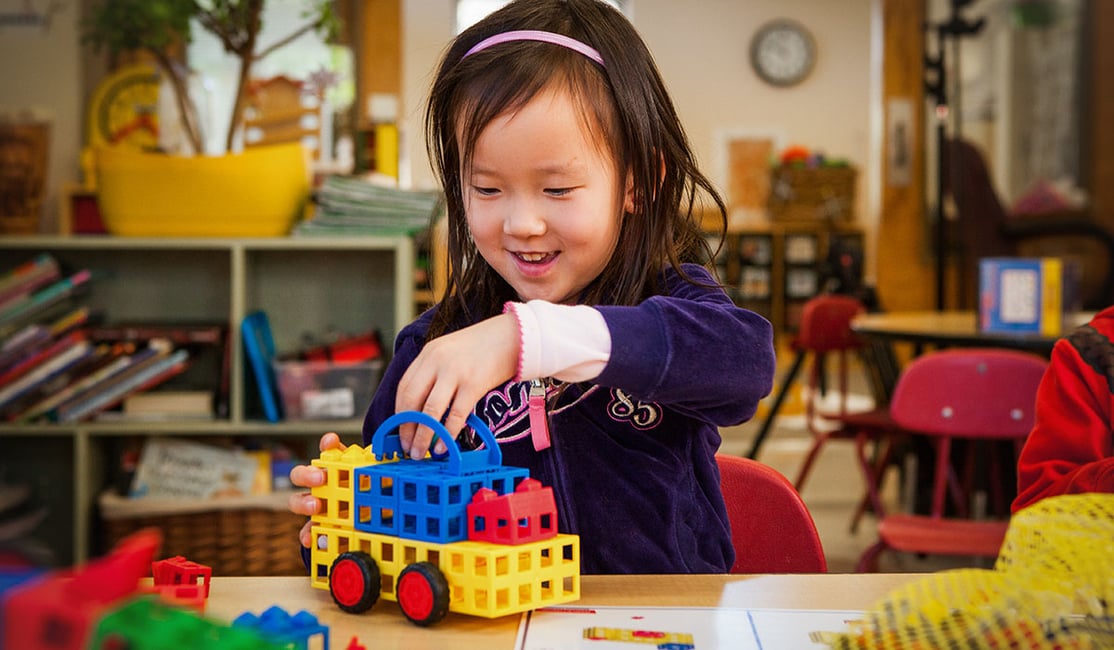
After ten years of research on STEM education for preschoolers and elementary students, we've got a lot to say about the importance of block play for young children as well as the importance of STEM mentors. In fact, our research shows that mentors (teachers, parents, grandparents....) aren't simply important—they're critical in helping children feel confident and capable in STEM.
Below are some tips that you can use when leading block play STEM activities for preschoolers and early elementary students, particularly if they're using the Foundational Fluencies STEM Lab.
Tip #1: Ask a lot of questions.
Questions provide more opportunity for the use of language for communication, strengthens adult-child connection, and allows insight into development/interests of the child, which can be useful in future interactions.
When a child says, “Look at my tower. Do you like it?” here are some ways you can respond to support a STEM identity and build 21st century skills:
- “Can you tell me exactly how you made it?” Asking kids to articulate their process step by step builds communication and logical thinking skills
- “What do you think would happen if…?” Encourages kids to apply their current knowledge to an unknown situation based on evidence and experience.
- “What was the hardest part? What did you do to overcome it?” By reflecting on a challenge and how they solved it, kids develop confidence and see themselves as problem-solving engineers.
- “Can you draw and label a picture of your creation so we can hang it up for others to see and learn from?” Highlights the community aspect of STEM and develops the skill of drawing a model to communicate an idea.
- “What advice would you give to a friend who wanted to build this?” Challenges kids to combine information, evaluate the most important aspects, and communicate clearly. If you ask kids to write down their advice, this integrates STEM and writing to build critical thinking and communication skills across disciplines.
Kids don’t need to learn STEM from expert scientists or engineers any more than children need their swim instructor to be an Olympic gold medalist. Kids need to learn STEM from the people who nurture them and know them well.
Tip #2: Take time to explore.
When introducing new STEM materials to your child give your child time to get out their natural curiosity and just play at first. Then, you can call attention to particular aspects of the material and start to engage with the curriculum. In other words, get their wiggles out first!
Tip #3: Integrate stories as much as possible.
Children love storytelling and this can be a wonderful tool to impart instruction. In some interactions, adults may tell stories during construction (using the blocks as characters/pieces in the stories) or in others, allowing children to reflect on their stories that have been completed. Writing children’s stories about their creations is another way to help children develop their communication skills. By personalizing the constructed piece, the children are easily able to relate to the construction process and seem to also enjoy themselves more. Therefore, a problem of attaching blocks together could be transformed into “my dog needs a head” etc.
Tip #4: Show your work.
When children have difficulty with block assembly, showing them how to solve their problem using your own model (rather than on theirs) is very effective. Resist the temptation to just snap it into place for them. Challenge and difficulty offers growth. Give your child the opportunity to build resilience by encouraging them to do things on their own and keep trying in the face of failure.
Tip #5: Be specific with encouragements and compliments.
Instead of saying that “I like what you built,” say “I like how you put that extra wheel on your car.” Not only can this open up a chance for more communication, it can also help to extend the child’s vocabulary in relation to something of immediate interest.
Tip #6: Play collaborative games with the blocks whenever possible.
You can start to construct a piece, but rather than finishing the piece, enlist your child's help and present the situation as a “problem,” needing their help to fix it. Try to encourage group games where the goal is collective instead of competitive. This helps build 21st century skills in children.
Tip #7: Respect the different ways children learn.
If a child doesn’t understand one kind of instruction, keep trying in different ways. A child may learn better by teaching others (interpersonal) or by using their bodies, hands, moving (bodily-kinesthetic) etc., visually through images/pictures (spatial), linguistic (through conversations, engaging in discussions), or self-directing (intrapersonal).
Tip #8: Learn to listen.
In adult-child interaction, adults can easily talk too much. Challenge yourself to be observant and extra conscious of how much "airtime" you take. With preschool children in particular, their verbal communications are often in a developing stage. Some children need time to process their thoughts and given space before communication is possible.
Tip #9: Avoid making assumptions about your child's creations.
Rather than asking “Is that a car?”, choose words that allow your child to describe their creation. Open ended questions or statements such as “Tell me about what you made” respects their individual creativity and open up further dialogue (rather than receiving only a ‘yes’ or ‘no’). After all, the object that looks like a car may in fact be a dinosaur!
Tip #10: Be flexible.
Learning isn't always linear, with one obvious ending. Having specific goals of instruction is important, but being too rigid removes the possibility for unexpected learning. Being flexible and open to new interpretations allows space for creativity and spontaneity to arise. For example, if your child attaches the wheels on the wrong side of his car, you could respond with how “cool” it is and admire “how (the car) can go both ways”. Children might notice their “mistakes” and make the correction independently from your direct help.
These tips will help you become even more effective as a STEM mentor during your STEM activities for preschoolers and early elementary students. It'll take some practice but we at Kid Spark know that being a STEM educator for preschool and elementary students is possible for any caring adult. Please don't hesitate to reach out with additional questions—we're here to help.

